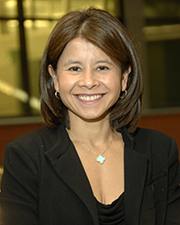
Amber Luong, MD, PhD
- Professor, IMM-Center for Neuroimmunology and Glial Biology and Department of Otorhinolaryngology – Head and Neck Surgery
Biography
Dr. Amber Luong received her MD/PhD in Molecular Genetics at the University of Texas Southwestern Medical Center at Dallas through the NIH sponsored Medical Scientist Training Program. She obtained her Ph.D. under the Nobel laureates Drs. Michael Brown and Joseph Goldstein for the identification and biochemical characterization of a novel human enzyme, acetyl coA synthetase. She then completed her otorhinolaryngology residency training at UT Southwestern and rhinology fellowship training at the Cleveland Clinic Foundation. It was during her residency training that she began work on a severe subtype of CRS, allergic fungal rhinosinusitis (AFRS)
Over 40 million Americans suffer from chronic rhinosinusitis (CRS) and CRS represents one of the most prevalent chronic illnesses in the United States. This translates conservatively to 18-22 million physician visits yearly with an annual direct treatment cost of about $3.4 billion. Despite this burden, much remains unknown about its pathophysiology, and current treatment options, which typically involve recurrent surgeries and anti-inflammatory agents, are not curative. Dr. Luong’s clinical background in management of CRS disease and research interest in the role of fungi in chronic airway inflammation provide unique insight into identifying novel therapeutic targets.
CRS is clinically classified into 2 groups defined by the absence or presence of nasal polyps. This clinical classification has been supported by immunologic profiles of the inflamed sinus tissue in which CRS without nasal polyps are characterized by predominance of neutrophils and elevated T helper cell type 1 (Th1) cytokines while CRS with nasal polyps (CRSwNP) have high presence of eosinophils, mast cells, and basophils and expression of T helper cell type 2 (Th2) cytokines such as IL-4, IL-5, and IL-13.
AFRS is associated with an accumulation of thick entrapped mucus laden with fungal hyphae and eosinophils between the nasal polyps and within sinus cavities. This trapped mucus can cause expansion of sinus cavities and ultimately erosion of bone separating the sinuses from the intracranial and orbital cavities which can result in intracranial complications and blindness, respectively.
Dr. Luong marries her clinical and research interests though studies on AFRS. She is currently interested in understanding how fungi stimulate the adaptive immune response in AFRS as well as other CRS subtypes. In addition, she is interested in molecular pathways stimulated by fungi and other environmental triggers such as bacteria and viruses within respiratory epithelial cells that lead to the exaggerated Th2 immune response.
RESEARCH PROJECTS
- Immunologic characterization of important cell types involved in the Th2 immune response
- Molecular signaling through respiratory epithelial cells of fungi alone and with other environmental triggers responsible for initiating and/or maintaining the characteristic Th2 immune response
- Clinical characterization and identification of biomarkers for CRS subtypes
Publications
Clark DW, Wenaas AE, Luong A, Citardi MJ, and Fakhri S. Chronic Rhinosinusitis with Nasal Polyps: Elevated serum IgE is associated with Staphylococcus aureus on culture. Int Forum of Allergy Rhinol. 2011 Nov;1(6):445-50. PMID:22144053
Isaacs, S, Fakhri S, Luong A, and Citardi MJ. A meta-analysis of topical amphotericin B for the treatment of chronic rhinosinusitis. Int Forum of Aller and Rhin. 2011 Jul-Aug;1(4):250-4.
Porter PC, Yan, T, Luong A, Delclos GL, Abramson SL, Kheradmand F, and Corry DB. Proteinases as Molecular Adjuvants in Allergic Airway Disease. Biochim Biophys Acta. 2011 Nov;1810(11):1059-65. PMID: 21712069
Pakdaman MN, Corry DB, and Luong A. Fungi Linking the Pathophysiology of Chronic Rhinosinusitis with Nasal Polyps and Allergic Asthma. Immunol Invest. 2011;40(7-8):767-85. PMID: 21985305
Shaw JL, Ashoori F, Fakhri S, Citardi MJ, and Luong AL. Increased Percentage of Mast Cells within Sinonasal Mucosa of Chronic Rhinosinusitis with Nasal Polyp Patients Independent of Atopy. Int Forum of Allergy Rhinol., 2012 Feb 16. [Epub ahead of print]